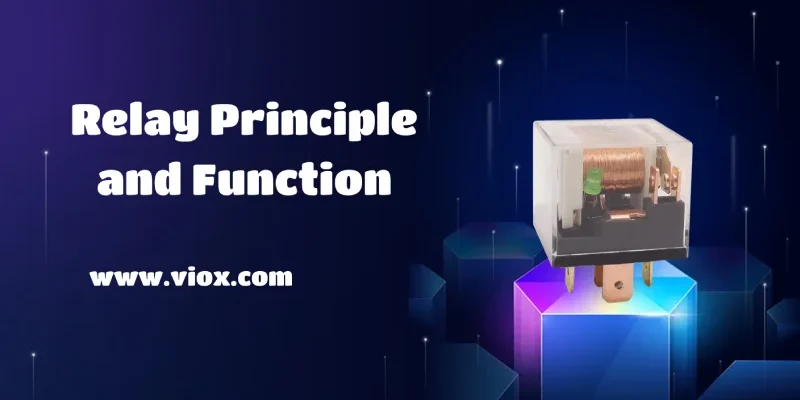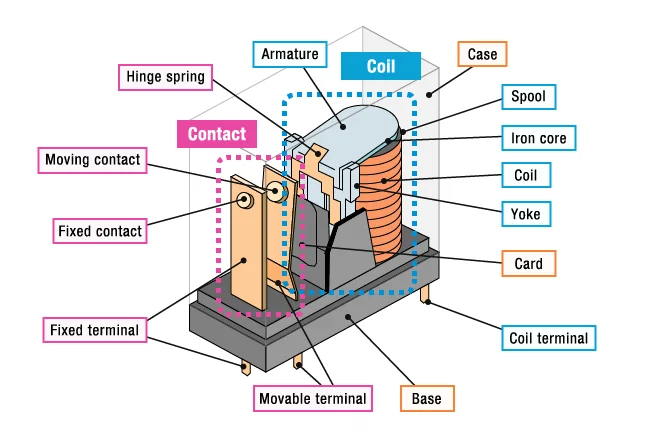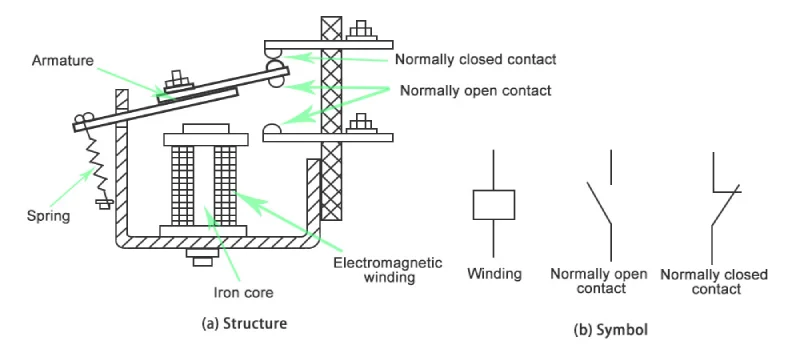Relės yra elektromechaniniai prietaisai, veikiantys kaip jungikliai, veikiantys elektromagnetinės traukos principu, skirti elektros grandinėms valdyti ir leidžiantys mažos galios signalais saugiai ir efektyviai valdyti didelės galios sistemas.
Relės struktūra ir simboliai
Kreditas OMRON
Elektromagnetines reles sudaro trys pagrindinės sudedamosios dalys: elektromagnetinė ritė, judanti varža ir kontaktai. Ritė, paprastai pagaminta iš izoliuotos vielos, apvyniotos aplink geležinę šerdį, įjungus įtampą sukuria magnetinį lauką. Šis magnetinis laukas pritraukia judančią geležinę dalį - inkarą, kuri keičia relės būseną.
Šių komponentų ir jų funkcijų simboliai elektrinėse schemose yra relės simboliai:
- Ritės simboliai: Dažnai vaizduojamas kaip apskritimas arba ovalas su dviem galais.
- Kontaktiniai simboliai: Rodomos kaip linijos, kurios gali būti atviros (paprastai atviros, NO) arba uždaros (paprastai uždaros, NC).
- Armatūra: Atvaizduojamas linija, jungiančia ritę su kontaktais.
Įprasti relės simboliai:
- SPST (vieno poliaus viengubo perjungimo): Vienas perjungiamas kontaktas.
- SPDT (vieno poliaus dvigubas perjungimas): Vienas perjungiamas kontaktas su dviem galimomis padėtimis.
- DPST/DPDT: Dvigubo poliaus versijos su dviem kontaktų rinkiniais.
Šie standartizuoti simboliai leidžia inžinieriams greitai suprasti relių konfigūracijas elektros grandinių schemose, palengvina efektyvų elektros sistemų projektavimą ir gedimų šalinimą.
Relės veikimo principas
Relės veikimo principas pagrįstas elektrinio ir magnetinio laukų sąveika. Kai relės rite teka srovė, ji sukuria magnetinį lauką, kuris pritraukia judančią inkariuotę. Ši varža yra sujungta su vienu ar keliais kontaktais, kurie, priklausomai nuo relės konfigūracijos, atidaro arba uždaro elektros grandines. Procesą sudaro:
- ritės įjungimas elektriniu signalu
- Magnetinio lauko sukūrimas aplink ritę
- Armatūros judėjimas dėl magnetinės traukos
- Kontaktų perjungimas grandinei valdyti
- Atjungus įtampą ritėje, armatūra grįžta į pradinę padėtį, dažnai padedama spyruoklinio mechanizmo.
Dėl šio paprasto, bet veiksmingo mechanizmo relės gali būti tarpininkais tarp mažos galios valdymo grandinių ir didelės galios apkrovos grandinių, todėl jos yra neįkainojamos įvairiose elektros ir elektronikos srityse.
Elektromagnetinės traukos mechanizmas
Relės veikimo esmė - elektromagnetinė trauka, kuri yra jos perjungimo mechanizmo pagrindas. Kai relės rite teka elektros srovė, ji sukuria magnetinį lauką, kuris jėga veikia judančią inkaro dalį. Ši varža mechaniškai sujungta su relės kontaktais, todėl, priklausomai nuo relės konfigūracijos, jie atsidaro arba užsidaro. Magnetinio lauko stipris, taigi ir jėga, veikianti inkarą, yra tiesiogiai proporcinga per ritę tekančiai srovei. Kai ritė išjungiama, spyruoklinis mechanizmas paprastai grąžina inkarą ir kontaktus į pradinę padėtį ir relę grąžina į pradinę padėtį. Ši elegantiška elektrinių ir mechaninių komponentų sąveika leidžia relėms veiksmingai valdyti didelės galios grandines naudojant mažos galios signalus, todėl jos yra labai svarbios įvairiose srityse, kur svarbiausia sauga ir automatizavimas.
Normaliai atviri ir uždari kontaktai
Relės gali būti sukonfigūruotos su įvairių tipų kontaktais, pirmiausia normaliai atvirais (NO) ir normaliai uždarais (NC). NO konfigūracijose grandinė lieka atvira, kai relė neįjungta, ir užsidaro, kai ji įjungiama. Ir atvirkščiai, NC konfigūracijose grandinė lieka uždara, kai relė neįjungta, ir atsidaro, kai ji įjungiama. Šis universalumas leidžia pritaikyti reles įvairioms reikmėms, pavyzdžiui, didelės galios grandinėms valdyti arba saugos mechanizmams įgyvendinti. NO ir NC kontaktų pasirinkimas priklauso nuo konkrečių sistemos reikalavimų, todėl inžinieriai gali projektuoti grandines, kurios tinkamai reaguoja ir į įprastas darbo sąlygas, ir į galimus gedimus.
Pagrindinės relių funkcijos
Relės atlieka daug svarbių funkcijų elektros sistemose, didindamos saugumą ir įgalindamos sudėtingus valdymo mechanizmus. Jos veikia kaip grandinių valdikliai, leidžiantys automatizuoti įvairius prietaisus, įjungiant ir išjungiant grandines pagal valdymo signalus. Be to, relės užtikrina svarbią apsaugą, nes, nustačius nesaugias sąlygas, atjungia maitinimą ir apsaugo grandines nuo perkrovų.
Šie universalūs prietaisai taip pat palengvina signalų izoliaciją, apsaugo nuo trukdžių tarp skirtingų grandinės dalių ir leidžia mažos galios prietaisams, pavyzdžiui, mikrovaldikliams, valdyti didelės galios apkrovas, pavyzdžiui, variklius ar šildytuvus, be tiesioginio elektrinio ryšio. Sudėtingose sistemose relės gali integruoti daugybę valdymo signalų, todėl įvairiose srityse galima taikyti pažangias automatizavimo ir valdymo schemas.
Relės tipai
Relės būna įvairių tipų, kiekvienas jų skirtas tam tikroms reikmėms ir darbo sąlygoms. Kai kurie įprasti tipai:
- Elektromagnetinės relės: Pagrindinė ir plačiausiai naudojama rūšis, veikianti elektromagnetinės traukos principu.
- Puslaidininkinės relės (SSR): Perjungimui naudojami puslaidininkiai, kurie, palyginti su elektromagnetinėmis relėmis, veikia greičiau ir yra ilgaamžiškesni.
- Nulinės relės: Naudojamas stikliniame vamzdelyje įmontuotas nendrinis jungiklis, pasižymintis dideliu perjungimo greičiu ir maža kontaktų varža.
- Laiko vėlinimo relės: Prieš įjungiant arba išjungiant kontaktus, galima naudoti uždelsimo mechanizmą, naudingą sekos ir proceso valdymui.
- Užraktinės relės: Išlaiko savo padėtį ir atjungus valdymo maitinimą, todėl idealiai tinka energiją taupančioms programoms.
Relės taip pat skirstomos pagal kontaktų konfigūracijas, pavyzdžiui, SPST (Single Pole Single Throw), SPDT (Single Pole Double Throw) ir DPDT (Double Pole Double Throw), kurių kiekviena pasižymi skirtingomis perjungimo galimybėmis. Relės tipo pasirinkimas priklauso nuo tokių veiksnių kaip perjungimo greitis, galios reikalavimai, aplinkos sąlygos ir specifiniai taikomosios programos poreikiai.




